ORGB 4871 Final Project: Comprehensive Analysis of Oticon Inc. Change
VerifiedAdded on 2022/09/01
|16
|5351
|20
Report
AI Summary
This report provides a comprehensive analysis of the organizational changes at Oticon Inc., a Danish hearing aid manufacturer, focusing on the period from the late 1980s. The report examines the company's shift from declining market share to a period of innovation and dominance, driven by Lars Kolind's 'spaghetti organization' approach. It explores the assumptions behind the changes, the assessment of these changes, and the evaluation of employee success. The report delves into Oticon's strategies, future trends, and the challenges faced, including market competition and the need for adaptation. The analysis covers the implementation of a new organizational model, the importance of knowledge management, and the factors influencing the success of the transition, including employee commitment and institutionalization of change. The report includes an assessment of the changes, the strategies employed, future trends and the challenges faced by the organization.
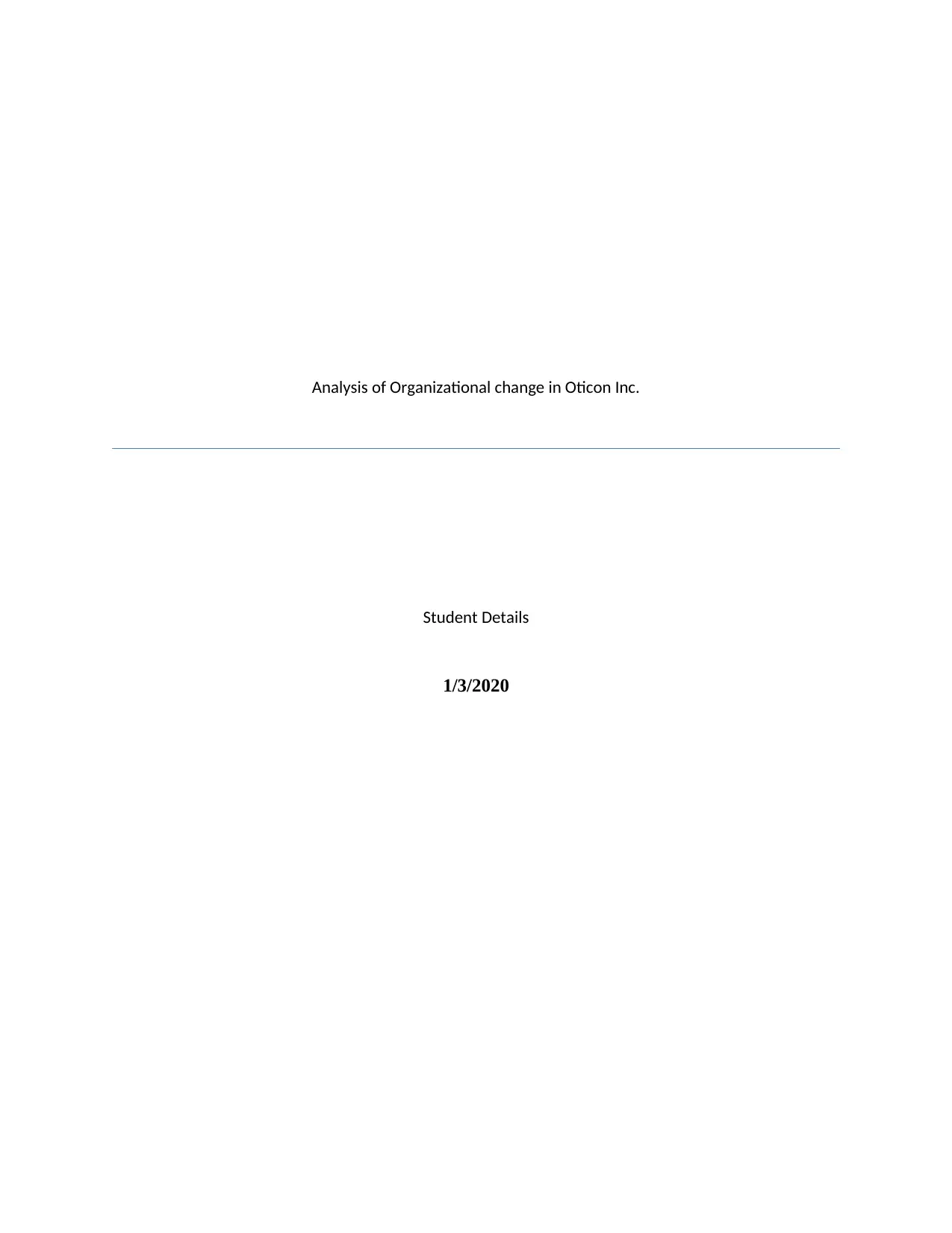
Analysis of Organizational change in Oticon Inc.
Student Details
1/3/2020
Student Details
1/3/2020
Paraphrase This Document
Need a fresh take? Get an instant paraphrase of this document with our AI Paraphraser
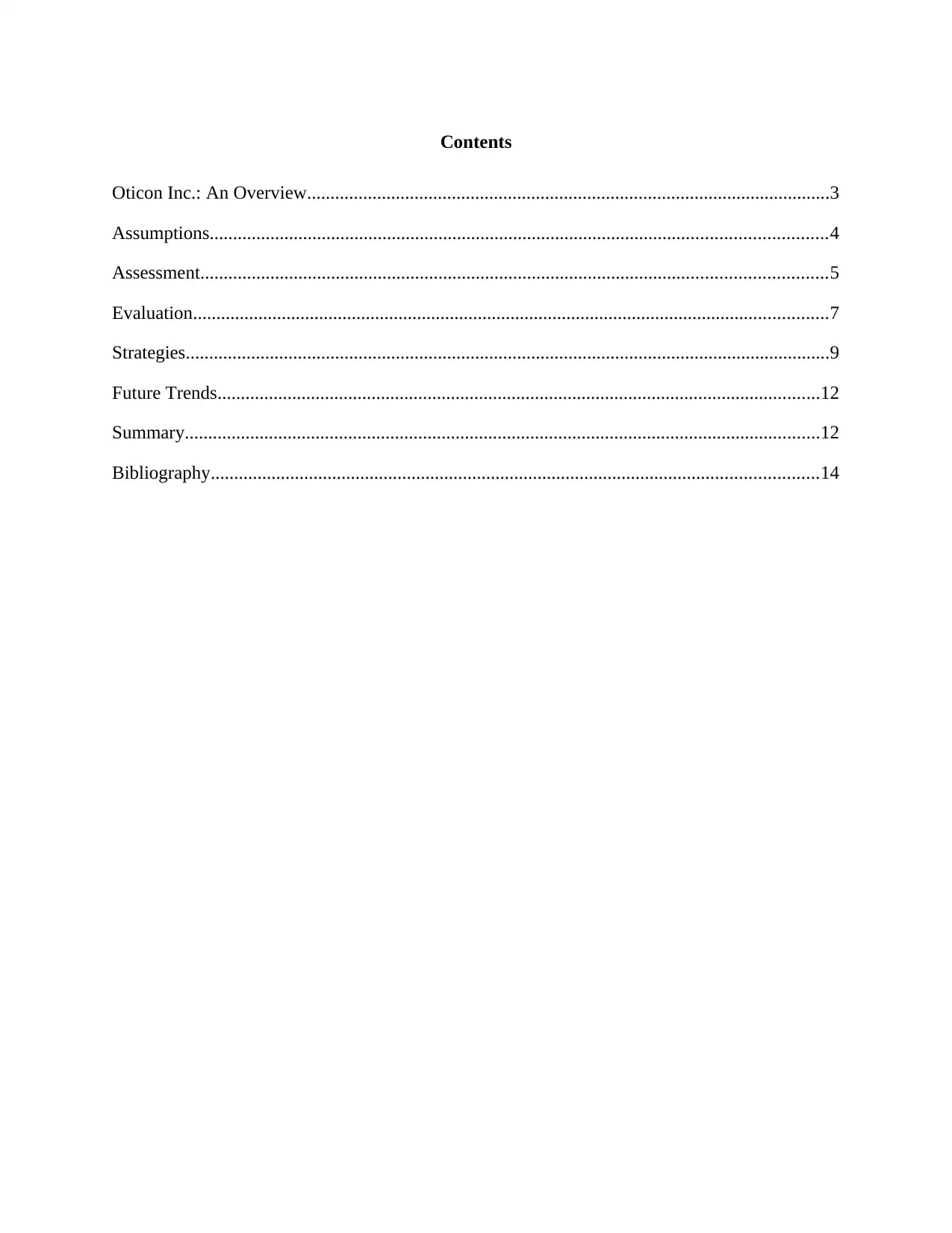
Contents
Oticon Inc.: An Overview................................................................................................................3
Assumptions....................................................................................................................................4
Assessment......................................................................................................................................5
Evaluation........................................................................................................................................7
Strategies..........................................................................................................................................9
Future Trends.................................................................................................................................12
Summary........................................................................................................................................12
Bibliography..................................................................................................................................14
Oticon Inc.: An Overview................................................................................................................3
Assumptions....................................................................................................................................4
Assessment......................................................................................................................................5
Evaluation........................................................................................................................................7
Strategies..........................................................................................................................................9
Future Trends.................................................................................................................................12
Summary........................................................................................................................................12
Bibliography..................................................................................................................................14
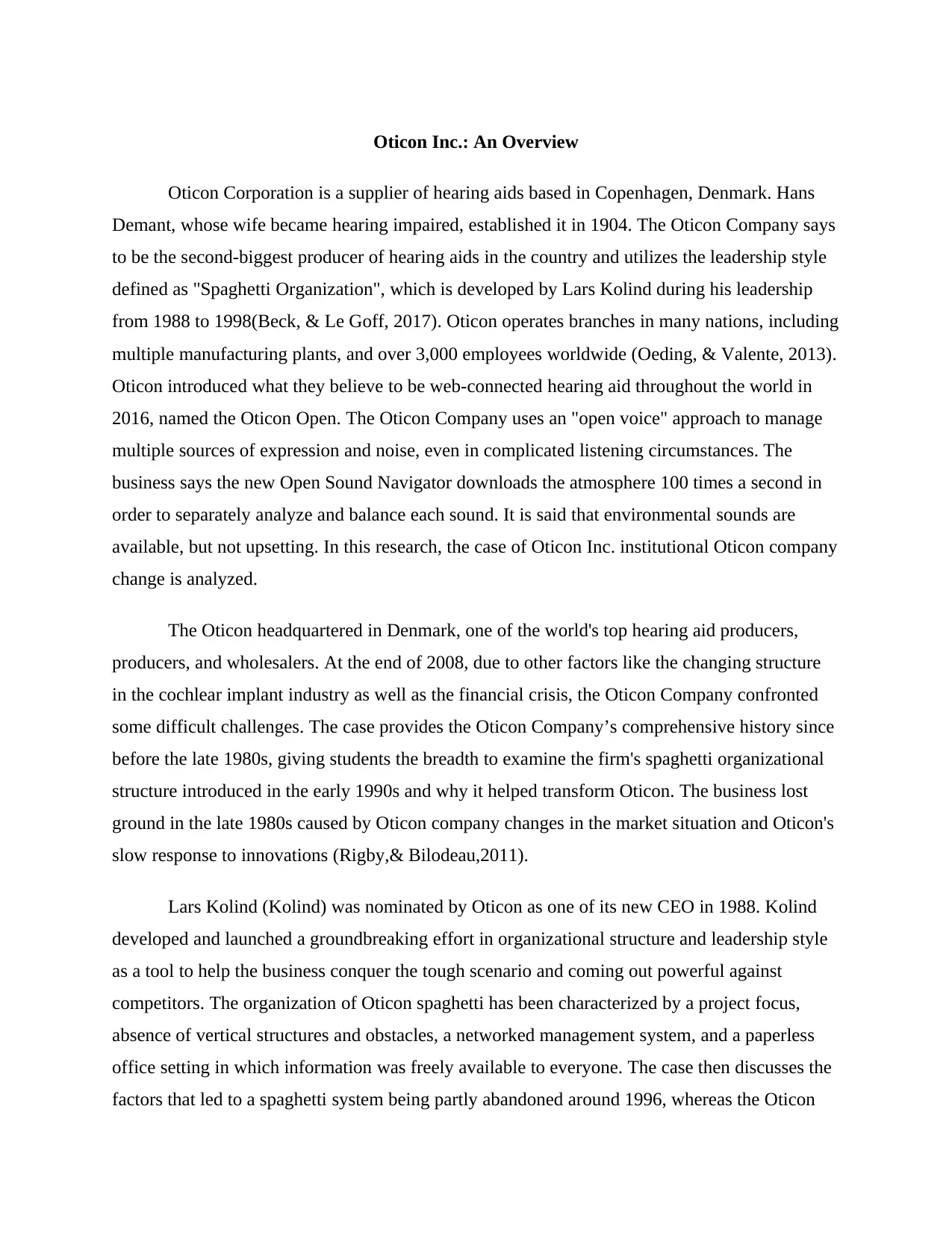
Oticon Inc.: An Overview
Oticon Corporation is a supplier of hearing aids based in Copenhagen, Denmark. Hans
Demant, whose wife became hearing impaired, established it in 1904. The Oticon Company says
to be the second-biggest producer of hearing aids in the country and utilizes the leadership style
defined as "Spaghetti Organization", which is developed by Lars Kolind during his leadership
from 1988 to 1998(Beck, & Le Goff, 2017). Oticon operates branches in many nations, including
multiple manufacturing plants, and over 3,000 employees worldwide (Oeding, & Valente, 2013).
Oticon introduced what they believe to be web-connected hearing aid throughout the world in
2016, named the Oticon Open. The Oticon Company uses an "open voice" approach to manage
multiple sources of expression and noise, even in complicated listening circumstances. The
business says the new Open Sound Navigator downloads the atmosphere 100 times a second in
order to separately analyze and balance each sound. It is said that environmental sounds are
available, but not upsetting. In this research, the case of Oticon Inc. institutional Oticon company
change is analyzed.
The Oticon headquartered in Denmark, one of the world's top hearing aid producers,
producers, and wholesalers. At the end of 2008, due to other factors like the changing structure
in the cochlear implant industry as well as the financial crisis, the Oticon Company confronted
some difficult challenges. The case provides the Oticon Company’s comprehensive history since
before the late 1980s, giving students the breadth to examine the firm's spaghetti organizational
structure introduced in the early 1990s and why it helped transform Oticon. The business lost
ground in the late 1980s caused by Oticon company changes in the market situation and Oticon's
slow response to innovations (Rigby,& Bilodeau,2011).
Lars Kolind (Kolind) was nominated by Oticon as one of its new CEO in 1988. Kolind
developed and launched a groundbreaking effort in organizational structure and leadership style
as a tool to help the business conquer the tough scenario and coming out powerful against
competitors. The organization of Oticon spaghetti has been characterized by a project focus,
absence of vertical structures and obstacles, a networked management system, and a paperless
office setting in which information was freely available to everyone. The case then discusses the
factors that led to a spaghetti system being partly abandoned around 1996, whereas the Oticon
Oticon Corporation is a supplier of hearing aids based in Copenhagen, Denmark. Hans
Demant, whose wife became hearing impaired, established it in 1904. The Oticon Company says
to be the second-biggest producer of hearing aids in the country and utilizes the leadership style
defined as "Spaghetti Organization", which is developed by Lars Kolind during his leadership
from 1988 to 1998(Beck, & Le Goff, 2017). Oticon operates branches in many nations, including
multiple manufacturing plants, and over 3,000 employees worldwide (Oeding, & Valente, 2013).
Oticon introduced what they believe to be web-connected hearing aid throughout the world in
2016, named the Oticon Open. The Oticon Company uses an "open voice" approach to manage
multiple sources of expression and noise, even in complicated listening circumstances. The
business says the new Open Sound Navigator downloads the atmosphere 100 times a second in
order to separately analyze and balance each sound. It is said that environmental sounds are
available, but not upsetting. In this research, the case of Oticon Inc. institutional Oticon company
change is analyzed.
The Oticon headquartered in Denmark, one of the world's top hearing aid producers,
producers, and wholesalers. At the end of 2008, due to other factors like the changing structure
in the cochlear implant industry as well as the financial crisis, the Oticon Company confronted
some difficult challenges. The case provides the Oticon Company’s comprehensive history since
before the late 1980s, giving students the breadth to examine the firm's spaghetti organizational
structure introduced in the early 1990s and why it helped transform Oticon. The business lost
ground in the late 1980s caused by Oticon company changes in the market situation and Oticon's
slow response to innovations (Rigby,& Bilodeau,2011).
Lars Kolind (Kolind) was nominated by Oticon as one of its new CEO in 1988. Kolind
developed and launched a groundbreaking effort in organizational structure and leadership style
as a tool to help the business conquer the tough scenario and coming out powerful against
competitors. The organization of Oticon spaghetti has been characterized by a project focus,
absence of vertical structures and obstacles, a networked management system, and a paperless
office setting in which information was freely available to everyone. The case then discusses the
factors that led to a spaghetti system being partly abandoned around 1996, whereas the Oticon
⊘ This is a preview!⊘
Do you want full access?
Subscribe today to unlock all pages.

Trusted by 1+ million students worldwide
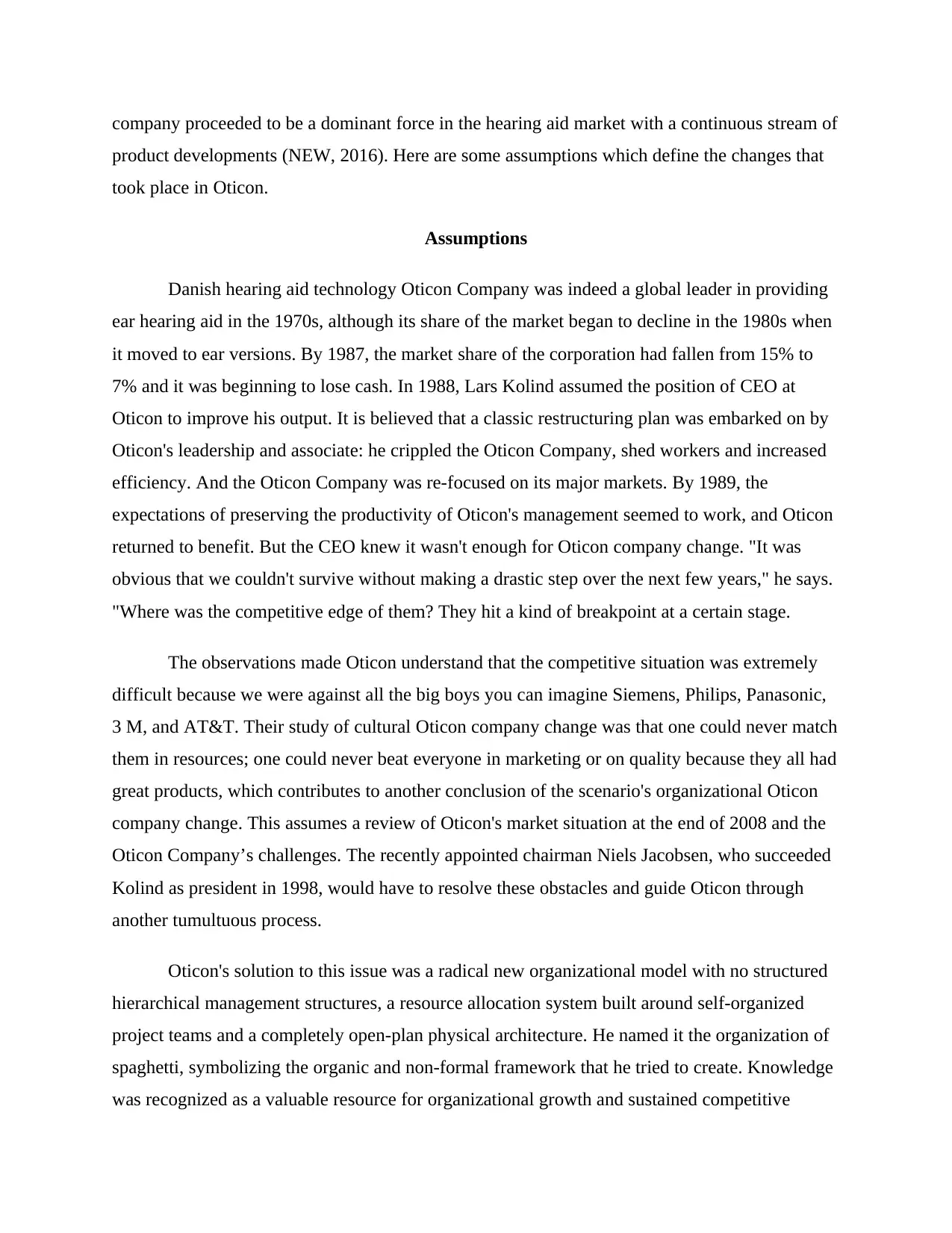
company proceeded to be a dominant force in the hearing aid market with a continuous stream of
product developments (NEW, 2016). Here are some assumptions which define the changes that
took place in Oticon.
Assumptions
Danish hearing aid technology Oticon Company was indeed a global leader in providing
ear hearing aid in the 1970s, although its share of the market began to decline in the 1980s when
it moved to ear versions. By 1987, the market share of the corporation had fallen from 15% to
7% and it was beginning to lose cash. In 1988, Lars Kolind assumed the position of CEO at
Oticon to improve his output. It is believed that a classic restructuring plan was embarked on by
Oticon's leadership and associate: he crippled the Oticon Company, shed workers and increased
efficiency. And the Oticon Company was re-focused on its major markets. By 1989, the
expectations of preserving the productivity of Oticon's management seemed to work, and Oticon
returned to benefit. But the CEO knew it wasn't enough for Oticon company change. "It was
obvious that we couldn't survive without making a drastic step over the next few years," he says.
"Where was the competitive edge of them? They hit a kind of breakpoint at a certain stage.
The observations made Oticon understand that the competitive situation was extremely
difficult because we were against all the big boys you can imagine Siemens, Philips, Panasonic,
3 M, and AT&T. Their study of cultural Oticon company change was that one could never match
them in resources; one could never beat everyone in marketing or on quality because they all had
great products, which contributes to another conclusion of the scenario's organizational Oticon
company change. This assumes a review of Oticon's market situation at the end of 2008 and the
Oticon Company’s challenges. The recently appointed chairman Niels Jacobsen, who succeeded
Kolind as president in 1998, would have to resolve these obstacles and guide Oticon through
another tumultuous process.
Oticon's solution to this issue was a radical new organizational model with no structured
hierarchical management structures, a resource allocation system built around self-organized
project teams and a completely open-plan physical architecture. He named it the organization of
spaghetti, symbolizing the organic and non-formal framework that he tried to create. Knowledge
was recognized as a valuable resource for organizational growth and sustained competitive
product developments (NEW, 2016). Here are some assumptions which define the changes that
took place in Oticon.
Assumptions
Danish hearing aid technology Oticon Company was indeed a global leader in providing
ear hearing aid in the 1970s, although its share of the market began to decline in the 1980s when
it moved to ear versions. By 1987, the market share of the corporation had fallen from 15% to
7% and it was beginning to lose cash. In 1988, Lars Kolind assumed the position of CEO at
Oticon to improve his output. It is believed that a classic restructuring plan was embarked on by
Oticon's leadership and associate: he crippled the Oticon Company, shed workers and increased
efficiency. And the Oticon Company was re-focused on its major markets. By 1989, the
expectations of preserving the productivity of Oticon's management seemed to work, and Oticon
returned to benefit. But the CEO knew it wasn't enough for Oticon company change. "It was
obvious that we couldn't survive without making a drastic step over the next few years," he says.
"Where was the competitive edge of them? They hit a kind of breakpoint at a certain stage.
The observations made Oticon understand that the competitive situation was extremely
difficult because we were against all the big boys you can imagine Siemens, Philips, Panasonic,
3 M, and AT&T. Their study of cultural Oticon company change was that one could never match
them in resources; one could never beat everyone in marketing or on quality because they all had
great products, which contributes to another conclusion of the scenario's organizational Oticon
company change. This assumes a review of Oticon's market situation at the end of 2008 and the
Oticon Company’s challenges. The recently appointed chairman Niels Jacobsen, who succeeded
Kolind as president in 1998, would have to resolve these obstacles and guide Oticon through
another tumultuous process.
Oticon's solution to this issue was a radical new organizational model with no structured
hierarchical management structures, a resource allocation system built around self-organized
project teams and a completely open-plan physical architecture. He named it the organization of
spaghetti, symbolizing the organic and non-formal framework that he tried to create. Knowledge
was recognized as a valuable resource for organizational growth and sustained competitive
Paraphrase This Document
Need a fresh take? Get an instant paraphrase of this document with our AI Paraphraser
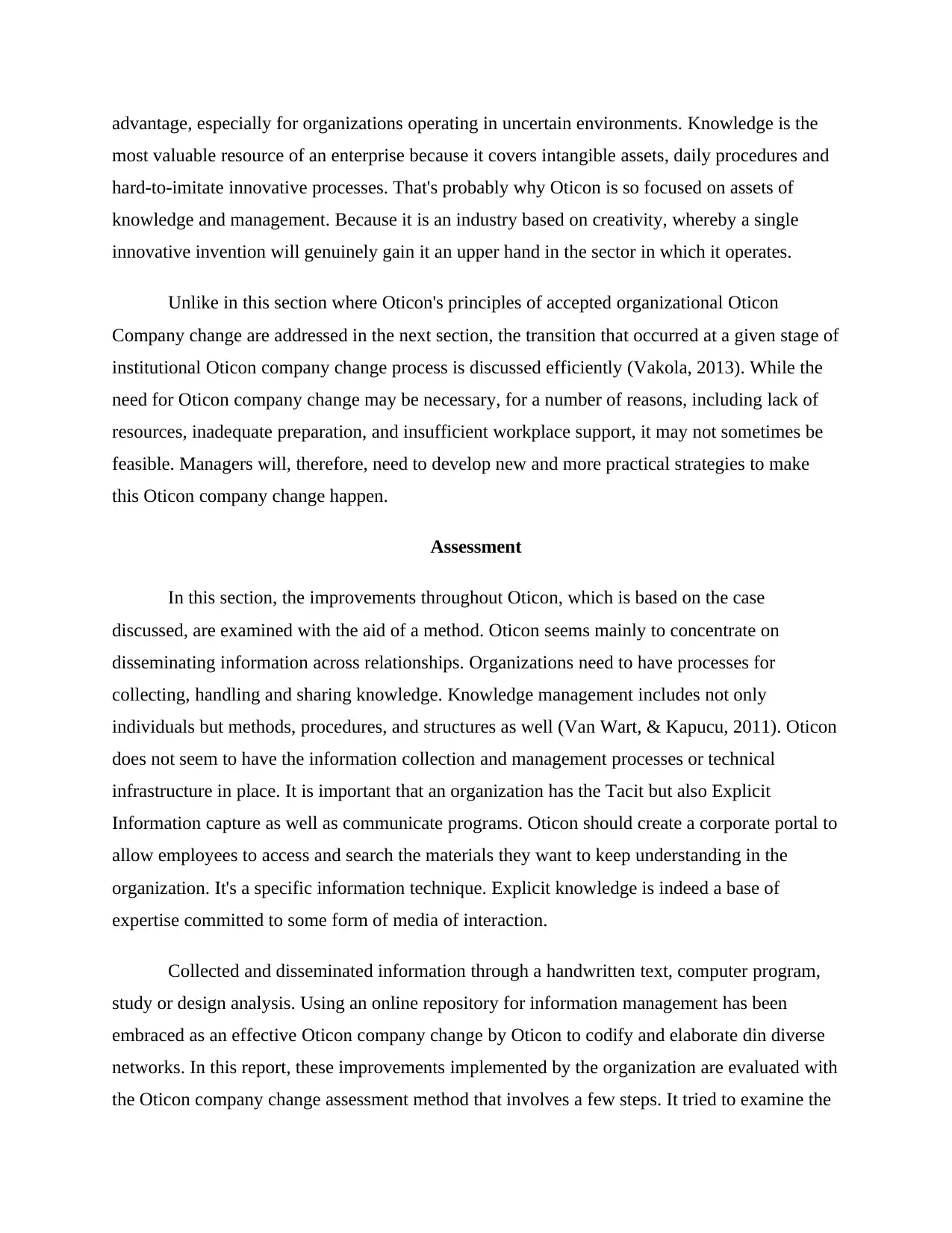
advantage, especially for organizations operating in uncertain environments. Knowledge is the
most valuable resource of an enterprise because it covers intangible assets, daily procedures and
hard-to-imitate innovative processes. That's probably why Oticon is so focused on assets of
knowledge and management. Because it is an industry based on creativity, whereby a single
innovative invention will genuinely gain it an upper hand in the sector in which it operates.
Unlike in this section where Oticon's principles of accepted organizational Oticon
Company change are addressed in the next section, the transition that occurred at a given stage of
institutional Oticon company change process is discussed efficiently (Vakola, 2013). While the
need for Oticon company change may be necessary, for a number of reasons, including lack of
resources, inadequate preparation, and insufficient workplace support, it may not sometimes be
feasible. Managers will, therefore, need to develop new and more practical strategies to make
this Oticon company change happen.
Assessment
In this section, the improvements throughout Oticon, which is based on the case
discussed, are examined with the aid of a method. Oticon seems mainly to concentrate on
disseminating information across relationships. Organizations need to have processes for
collecting, handling and sharing knowledge. Knowledge management includes not only
individuals but methods, procedures, and structures as well (Van Wart, & Kapucu, 2011). Oticon
does not seem to have the information collection and management processes or technical
infrastructure in place. It is important that an organization has the Tacit but also Explicit
Information capture as well as communicate programs. Oticon should create a corporate portal to
allow employees to access and search the materials they want to keep understanding in the
organization. It's a specific information technique. Explicit knowledge is indeed a base of
expertise committed to some form of media of interaction.
Collected and disseminated information through a handwritten text, computer program,
study or design analysis. Using an online repository for information management has been
embraced as an effective Oticon company change by Oticon to codify and elaborate din diverse
networks. In this report, these improvements implemented by the organization are evaluated with
the Oticon company change assessment method that involves a few steps. It tried to examine the
most valuable resource of an enterprise because it covers intangible assets, daily procedures and
hard-to-imitate innovative processes. That's probably why Oticon is so focused on assets of
knowledge and management. Because it is an industry based on creativity, whereby a single
innovative invention will genuinely gain it an upper hand in the sector in which it operates.
Unlike in this section where Oticon's principles of accepted organizational Oticon
Company change are addressed in the next section, the transition that occurred at a given stage of
institutional Oticon company change process is discussed efficiently (Vakola, 2013). While the
need for Oticon company change may be necessary, for a number of reasons, including lack of
resources, inadequate preparation, and insufficient workplace support, it may not sometimes be
feasible. Managers will, therefore, need to develop new and more practical strategies to make
this Oticon company change happen.
Assessment
In this section, the improvements throughout Oticon, which is based on the case
discussed, are examined with the aid of a method. Oticon seems mainly to concentrate on
disseminating information across relationships. Organizations need to have processes for
collecting, handling and sharing knowledge. Knowledge management includes not only
individuals but methods, procedures, and structures as well (Van Wart, & Kapucu, 2011). Oticon
does not seem to have the information collection and management processes or technical
infrastructure in place. It is important that an organization has the Tacit but also Explicit
Information capture as well as communicate programs. Oticon should create a corporate portal to
allow employees to access and search the materials they want to keep understanding in the
organization. It's a specific information technique. Explicit knowledge is indeed a base of
expertise committed to some form of media of interaction.
Collected and disseminated information through a handwritten text, computer program,
study or design analysis. Using an online repository for information management has been
embraced as an effective Oticon company change by Oticon to codify and elaborate din diverse
networks. In this report, these improvements implemented by the organization are evaluated with
the Oticon company change assessment method that involves a few steps. It tried to examine the
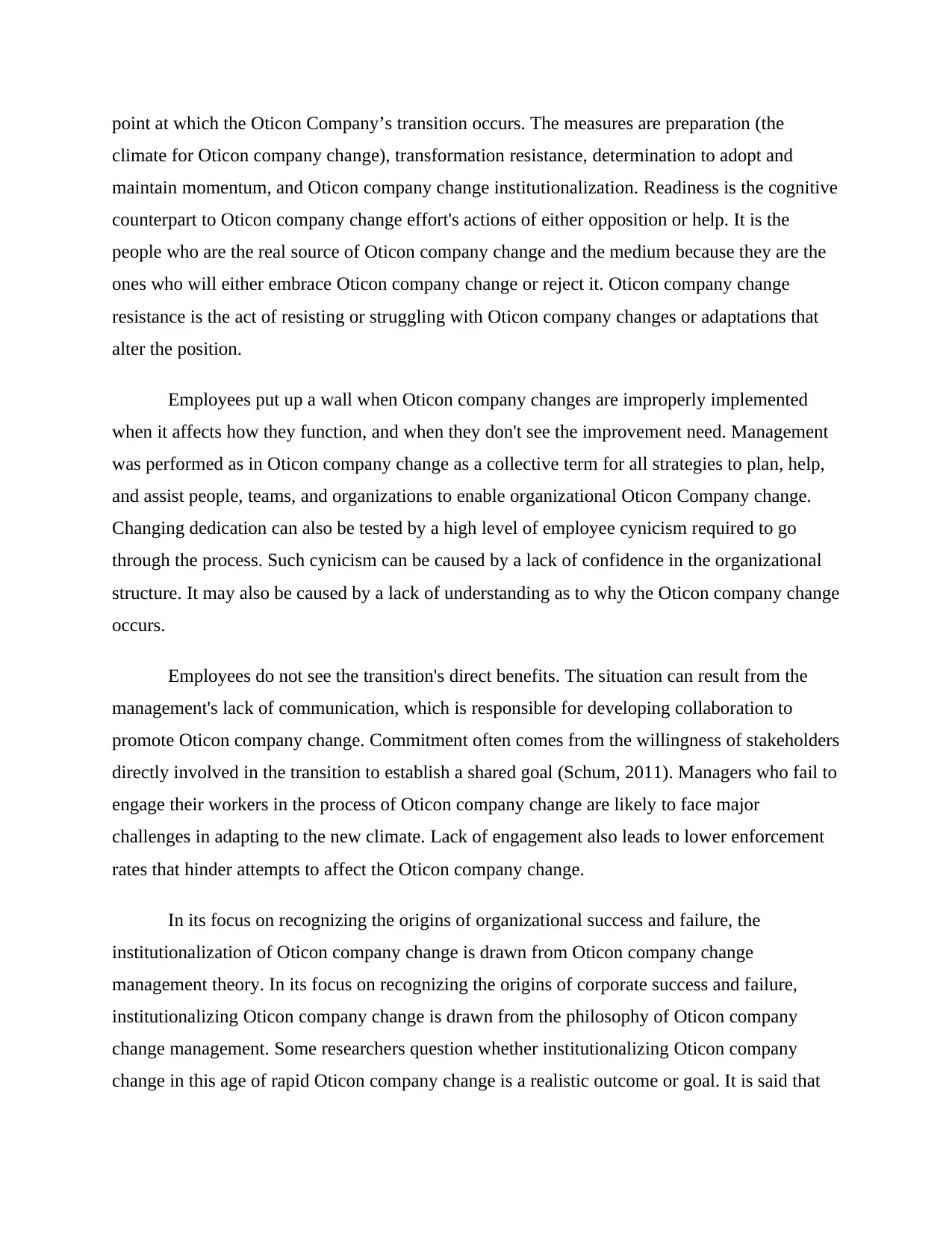
point at which the Oticon Company’s transition occurs. The measures are preparation (the
climate for Oticon company change), transformation resistance, determination to adopt and
maintain momentum, and Oticon company change institutionalization. Readiness is the cognitive
counterpart to Oticon company change effort's actions of either opposition or help. It is the
people who are the real source of Oticon company change and the medium because they are the
ones who will either embrace Oticon company change or reject it. Oticon company change
resistance is the act of resisting or struggling with Oticon company changes or adaptations that
alter the position.
Employees put up a wall when Oticon company changes are improperly implemented
when it affects how they function, and when they don't see the improvement need. Management
was performed as in Oticon company change as a collective term for all strategies to plan, help,
and assist people, teams, and organizations to enable organizational Oticon Company change.
Changing dedication can also be tested by a high level of employee cynicism required to go
through the process. Such cynicism can be caused by a lack of confidence in the organizational
structure. It may also be caused by a lack of understanding as to why the Oticon company change
occurs.
Employees do not see the transition's direct benefits. The situation can result from the
management's lack of communication, which is responsible for developing collaboration to
promote Oticon company change. Commitment often comes from the willingness of stakeholders
directly involved in the transition to establish a shared goal (Schum, 2011). Managers who fail to
engage their workers in the process of Oticon company change are likely to face major
challenges in adapting to the new climate. Lack of engagement also leads to lower enforcement
rates that hinder attempts to affect the Oticon company change.
In its focus on recognizing the origins of organizational success and failure, the
institutionalization of Oticon company change is drawn from Oticon company change
management theory. In its focus on recognizing the origins of corporate success and failure,
institutionalizing Oticon company change is drawn from the philosophy of Oticon company
change management. Some researchers question whether institutionalizing Oticon company
change in this age of rapid Oticon company change is a realistic outcome or goal. It is said that
climate for Oticon company change), transformation resistance, determination to adopt and
maintain momentum, and Oticon company change institutionalization. Readiness is the cognitive
counterpart to Oticon company change effort's actions of either opposition or help. It is the
people who are the real source of Oticon company change and the medium because they are the
ones who will either embrace Oticon company change or reject it. Oticon company change
resistance is the act of resisting or struggling with Oticon company changes or adaptations that
alter the position.
Employees put up a wall when Oticon company changes are improperly implemented
when it affects how they function, and when they don't see the improvement need. Management
was performed as in Oticon company change as a collective term for all strategies to plan, help,
and assist people, teams, and organizations to enable organizational Oticon Company change.
Changing dedication can also be tested by a high level of employee cynicism required to go
through the process. Such cynicism can be caused by a lack of confidence in the organizational
structure. It may also be caused by a lack of understanding as to why the Oticon company change
occurs.
Employees do not see the transition's direct benefits. The situation can result from the
management's lack of communication, which is responsible for developing collaboration to
promote Oticon company change. Commitment often comes from the willingness of stakeholders
directly involved in the transition to establish a shared goal (Schum, 2011). Managers who fail to
engage their workers in the process of Oticon company change are likely to face major
challenges in adapting to the new climate. Lack of engagement also leads to lower enforcement
rates that hinder attempts to affect the Oticon company change.
In its focus on recognizing the origins of organizational success and failure, the
institutionalization of Oticon company change is drawn from Oticon company change
management theory. In its focus on recognizing the origins of corporate success and failure,
institutionalizing Oticon company change is drawn from the philosophy of Oticon company
change management. Some researchers question whether institutionalizing Oticon company
change in this age of rapid Oticon company change is a realistic outcome or goal. It is said that
⊘ This is a preview!⊘
Do you want full access?
Subscribe today to unlock all pages.

Trusted by 1+ million students worldwide
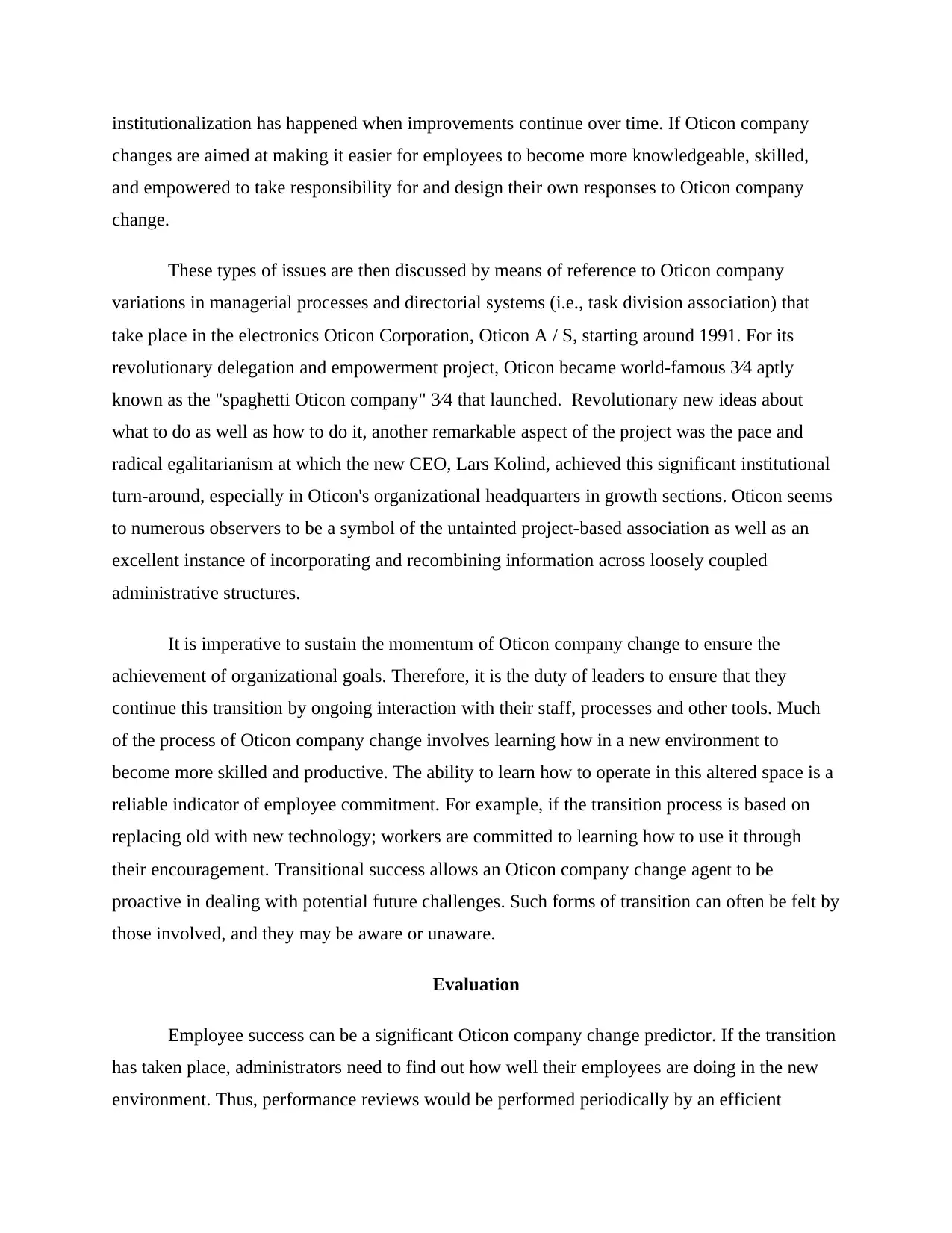
institutionalization has happened when improvements continue over time. If Oticon company
changes are aimed at making it easier for employees to become more knowledgeable, skilled,
and empowered to take responsibility for and design their own responses to Oticon company
change.
These types of issues are then discussed by means of reference to Oticon company
variations in managerial processes and directorial systems (i.e., task division association) that
take place in the electronics Oticon Corporation, Oticon A / S, starting around 1991. For its
revolutionary delegation and empowerment project, Oticon became world-famous 3⁄4 aptly
known as the "spaghetti Oticon company" 3⁄4 that launched. Revolutionary new ideas about
what to do as well as how to do it, another remarkable aspect of the project was the pace and
radical egalitarianism at which the new CEO, Lars Kolind, achieved this significant institutional
turn-around, especially in Oticon's organizational headquarters in growth sections. Oticon seems
to numerous observers to be a symbol of the untainted project-based association as well as an
excellent instance of incorporating and recombining information across loosely coupled
administrative structures.
It is imperative to sustain the momentum of Oticon company change to ensure the
achievement of organizational goals. Therefore, it is the duty of leaders to ensure that they
continue this transition by ongoing interaction with their staff, processes and other tools. Much
of the process of Oticon company change involves learning how in a new environment to
become more skilled and productive. The ability to learn how to operate in this altered space is a
reliable indicator of employee commitment. For example, if the transition process is based on
replacing old with new technology; workers are committed to learning how to use it through
their encouragement. Transitional success allows an Oticon company change agent to be
proactive in dealing with potential future challenges. Such forms of transition can often be felt by
those involved, and they may be aware or unaware.
Evaluation
Employee success can be a significant Oticon company change predictor. If the transition
has taken place, administrators need to find out how well their employees are doing in the new
environment. Thus, performance reviews would be performed periodically by an efficient
changes are aimed at making it easier for employees to become more knowledgeable, skilled,
and empowered to take responsibility for and design their own responses to Oticon company
change.
These types of issues are then discussed by means of reference to Oticon company
variations in managerial processes and directorial systems (i.e., task division association) that
take place in the electronics Oticon Corporation, Oticon A / S, starting around 1991. For its
revolutionary delegation and empowerment project, Oticon became world-famous 3⁄4 aptly
known as the "spaghetti Oticon company" 3⁄4 that launched. Revolutionary new ideas about
what to do as well as how to do it, another remarkable aspect of the project was the pace and
radical egalitarianism at which the new CEO, Lars Kolind, achieved this significant institutional
turn-around, especially in Oticon's organizational headquarters in growth sections. Oticon seems
to numerous observers to be a symbol of the untainted project-based association as well as an
excellent instance of incorporating and recombining information across loosely coupled
administrative structures.
It is imperative to sustain the momentum of Oticon company change to ensure the
achievement of organizational goals. Therefore, it is the duty of leaders to ensure that they
continue this transition by ongoing interaction with their staff, processes and other tools. Much
of the process of Oticon company change involves learning how in a new environment to
become more skilled and productive. The ability to learn how to operate in this altered space is a
reliable indicator of employee commitment. For example, if the transition process is based on
replacing old with new technology; workers are committed to learning how to use it through
their encouragement. Transitional success allows an Oticon company change agent to be
proactive in dealing with potential future challenges. Such forms of transition can often be felt by
those involved, and they may be aware or unaware.
Evaluation
Employee success can be a significant Oticon company change predictor. If the transition
has taken place, administrators need to find out how well their employees are doing in the new
environment. Thus, performance reviews would be performed periodically by an efficient
Paraphrase This Document
Need a fresh take? Get an instant paraphrase of this document with our AI Paraphraser
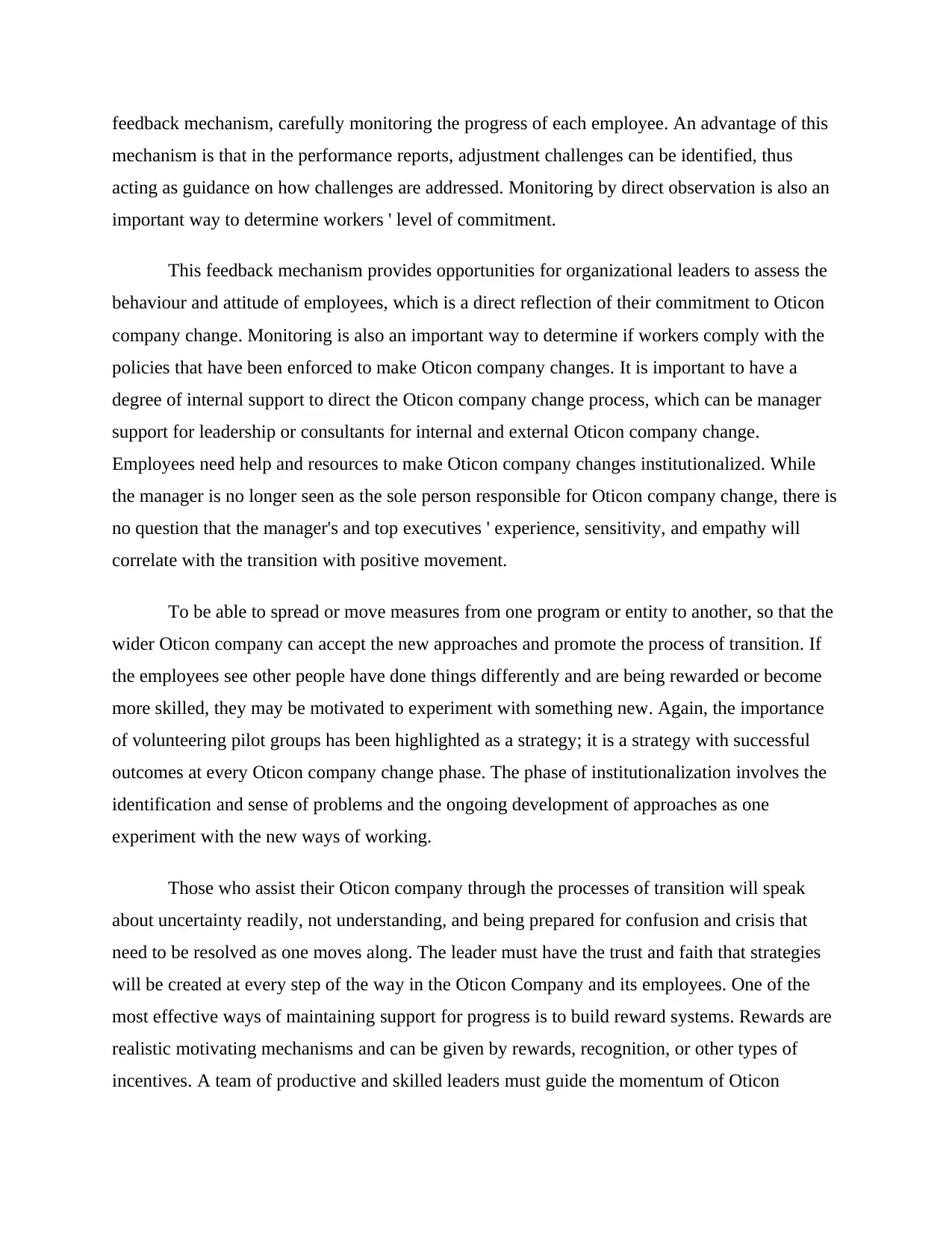
feedback mechanism, carefully monitoring the progress of each employee. An advantage of this
mechanism is that in the performance reports, adjustment challenges can be identified, thus
acting as guidance on how challenges are addressed. Monitoring by direct observation is also an
important way to determine workers ' level of commitment.
This feedback mechanism provides opportunities for organizational leaders to assess the
behaviour and attitude of employees, which is a direct reflection of their commitment to Oticon
company change. Monitoring is also an important way to determine if workers comply with the
policies that have been enforced to make Oticon company changes. It is important to have a
degree of internal support to direct the Oticon company change process, which can be manager
support for leadership or consultants for internal and external Oticon company change.
Employees need help and resources to make Oticon company changes institutionalized. While
the manager is no longer seen as the sole person responsible for Oticon company change, there is
no question that the manager's and top executives ' experience, sensitivity, and empathy will
correlate with the transition with positive movement.
To be able to spread or move measures from one program or entity to another, so that the
wider Oticon company can accept the new approaches and promote the process of transition. If
the employees see other people have done things differently and are being rewarded or become
more skilled, they may be motivated to experiment with something new. Again, the importance
of volunteering pilot groups has been highlighted as a strategy; it is a strategy with successful
outcomes at every Oticon company change phase. The phase of institutionalization involves the
identification and sense of problems and the ongoing development of approaches as one
experiment with the new ways of working.
Those who assist their Oticon company through the processes of transition will speak
about uncertainty readily, not understanding, and being prepared for confusion and crisis that
need to be resolved as one moves along. The leader must have the trust and faith that strategies
will be created at every step of the way in the Oticon Company and its employees. One of the
most effective ways of maintaining support for progress is to build reward systems. Rewards are
realistic motivating mechanisms and can be given by rewards, recognition, or other types of
incentives. A team of productive and skilled leaders must guide the momentum of Oticon
mechanism is that in the performance reports, adjustment challenges can be identified, thus
acting as guidance on how challenges are addressed. Monitoring by direct observation is also an
important way to determine workers ' level of commitment.
This feedback mechanism provides opportunities for organizational leaders to assess the
behaviour and attitude of employees, which is a direct reflection of their commitment to Oticon
company change. Monitoring is also an important way to determine if workers comply with the
policies that have been enforced to make Oticon company changes. It is important to have a
degree of internal support to direct the Oticon company change process, which can be manager
support for leadership or consultants for internal and external Oticon company change.
Employees need help and resources to make Oticon company changes institutionalized. While
the manager is no longer seen as the sole person responsible for Oticon company change, there is
no question that the manager's and top executives ' experience, sensitivity, and empathy will
correlate with the transition with positive movement.
To be able to spread or move measures from one program or entity to another, so that the
wider Oticon company can accept the new approaches and promote the process of transition. If
the employees see other people have done things differently and are being rewarded or become
more skilled, they may be motivated to experiment with something new. Again, the importance
of volunteering pilot groups has been highlighted as a strategy; it is a strategy with successful
outcomes at every Oticon company change phase. The phase of institutionalization involves the
identification and sense of problems and the ongoing development of approaches as one
experiment with the new ways of working.
Those who assist their Oticon company through the processes of transition will speak
about uncertainty readily, not understanding, and being prepared for confusion and crisis that
need to be resolved as one moves along. The leader must have the trust and faith that strategies
will be created at every step of the way in the Oticon Company and its employees. One of the
most effective ways of maintaining support for progress is to build reward systems. Rewards are
realistic motivating mechanisms and can be given by rewards, recognition, or other types of
incentives. A team of productive and skilled leaders must guide the momentum of Oticon
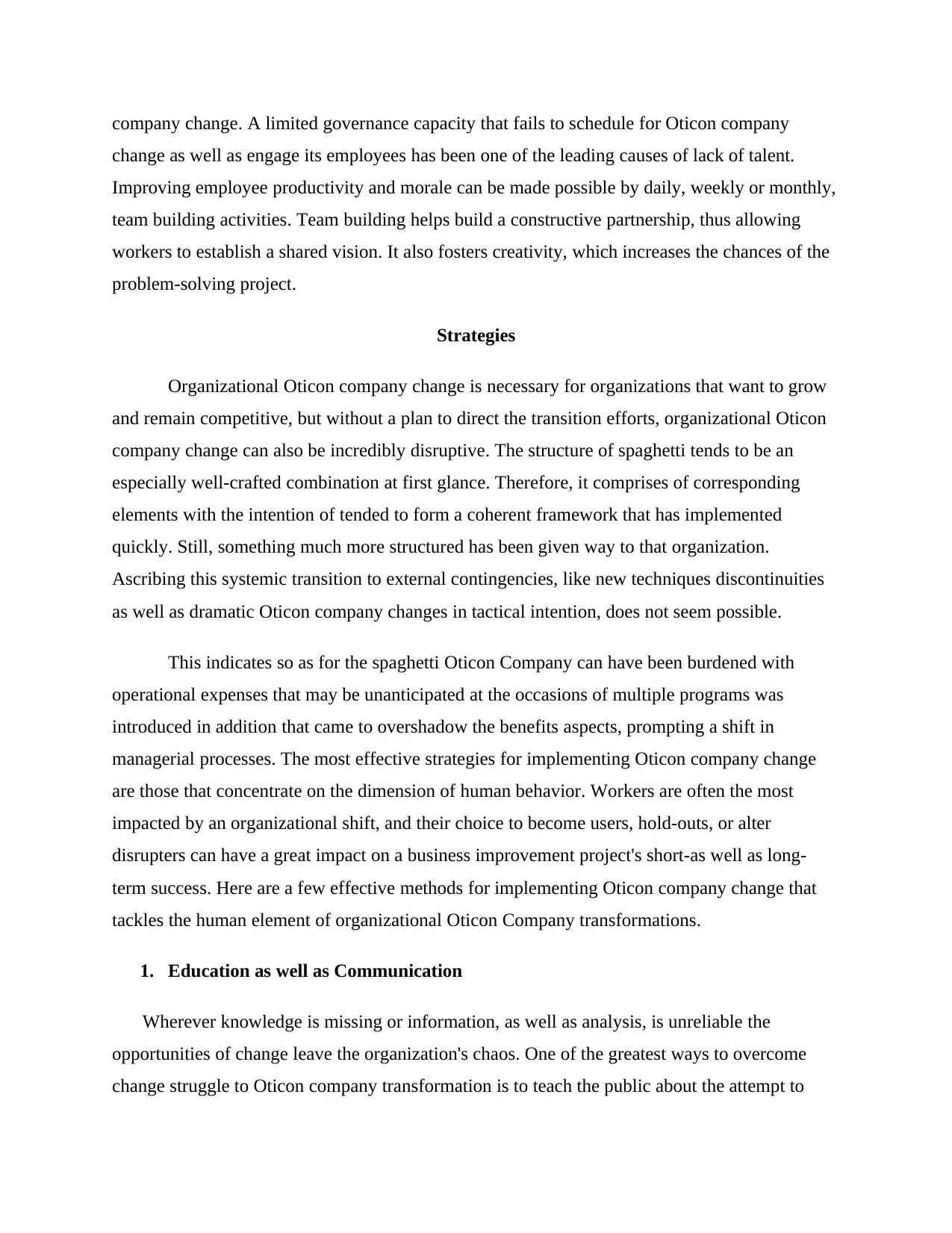
company change. A limited governance capacity that fails to schedule for Oticon company
change as well as engage its employees has been one of the leading causes of lack of talent.
Improving employee productivity and morale can be made possible by daily, weekly or monthly,
team building activities. Team building helps build a constructive partnership, thus allowing
workers to establish a shared vision. It also fosters creativity, which increases the chances of the
problem-solving project.
Strategies
Organizational Oticon company change is necessary for organizations that want to grow
and remain competitive, but without a plan to direct the transition efforts, organizational Oticon
company change can also be incredibly disruptive. The structure of spaghetti tends to be an
especially well-crafted combination at first glance. Therefore, it comprises of corresponding
elements with the intention of tended to form a coherent framework that has implemented
quickly. Still, something much more structured has been given way to that organization.
Ascribing this systemic transition to external contingencies, like new techniques discontinuities
as well as dramatic Oticon company changes in tactical intention, does not seem possible.
This indicates so as for the spaghetti Oticon Company can have been burdened with
operational expenses that may be unanticipated at the occasions of multiple programs was
introduced in addition that came to overshadow the benefits aspects, prompting a shift in
managerial processes. The most effective strategies for implementing Oticon company change
are those that concentrate on the dimension of human behavior. Workers are often the most
impacted by an organizational shift, and their choice to become users, hold-outs, or alter
disrupters can have a great impact on a business improvement project's short-as well as long-
term success. Here are a few effective methods for implementing Oticon company change that
tackles the human element of organizational Oticon Company transformations.
1. Education as well as Communication
Wherever knowledge is missing or information, as well as analysis, is unreliable the
opportunities of change leave the organization's chaos. One of the greatest ways to overcome
change struggle to Oticon company transformation is to teach the public about the attempt to
change as well as engage its employees has been one of the leading causes of lack of talent.
Improving employee productivity and morale can be made possible by daily, weekly or monthly,
team building activities. Team building helps build a constructive partnership, thus allowing
workers to establish a shared vision. It also fosters creativity, which increases the chances of the
problem-solving project.
Strategies
Organizational Oticon company change is necessary for organizations that want to grow
and remain competitive, but without a plan to direct the transition efforts, organizational Oticon
company change can also be incredibly disruptive. The structure of spaghetti tends to be an
especially well-crafted combination at first glance. Therefore, it comprises of corresponding
elements with the intention of tended to form a coherent framework that has implemented
quickly. Still, something much more structured has been given way to that organization.
Ascribing this systemic transition to external contingencies, like new techniques discontinuities
as well as dramatic Oticon company changes in tactical intention, does not seem possible.
This indicates so as for the spaghetti Oticon Company can have been burdened with
operational expenses that may be unanticipated at the occasions of multiple programs was
introduced in addition that came to overshadow the benefits aspects, prompting a shift in
managerial processes. The most effective strategies for implementing Oticon company change
are those that concentrate on the dimension of human behavior. Workers are often the most
impacted by an organizational shift, and their choice to become users, hold-outs, or alter
disrupters can have a great impact on a business improvement project's short-as well as long-
term success. Here are a few effective methods for implementing Oticon company change that
tackles the human element of organizational Oticon Company transformations.
1. Education as well as Communication
Wherever knowledge is missing or information, as well as analysis, is unreliable the
opportunities of change leave the organization's chaos. One of the greatest ways to overcome
change struggle to Oticon company transformation is to teach the public about the attempt to
⊘ This is a preview!⊘
Do you want full access?
Subscribe today to unlock all pages.

Trusted by 1+ million students worldwide
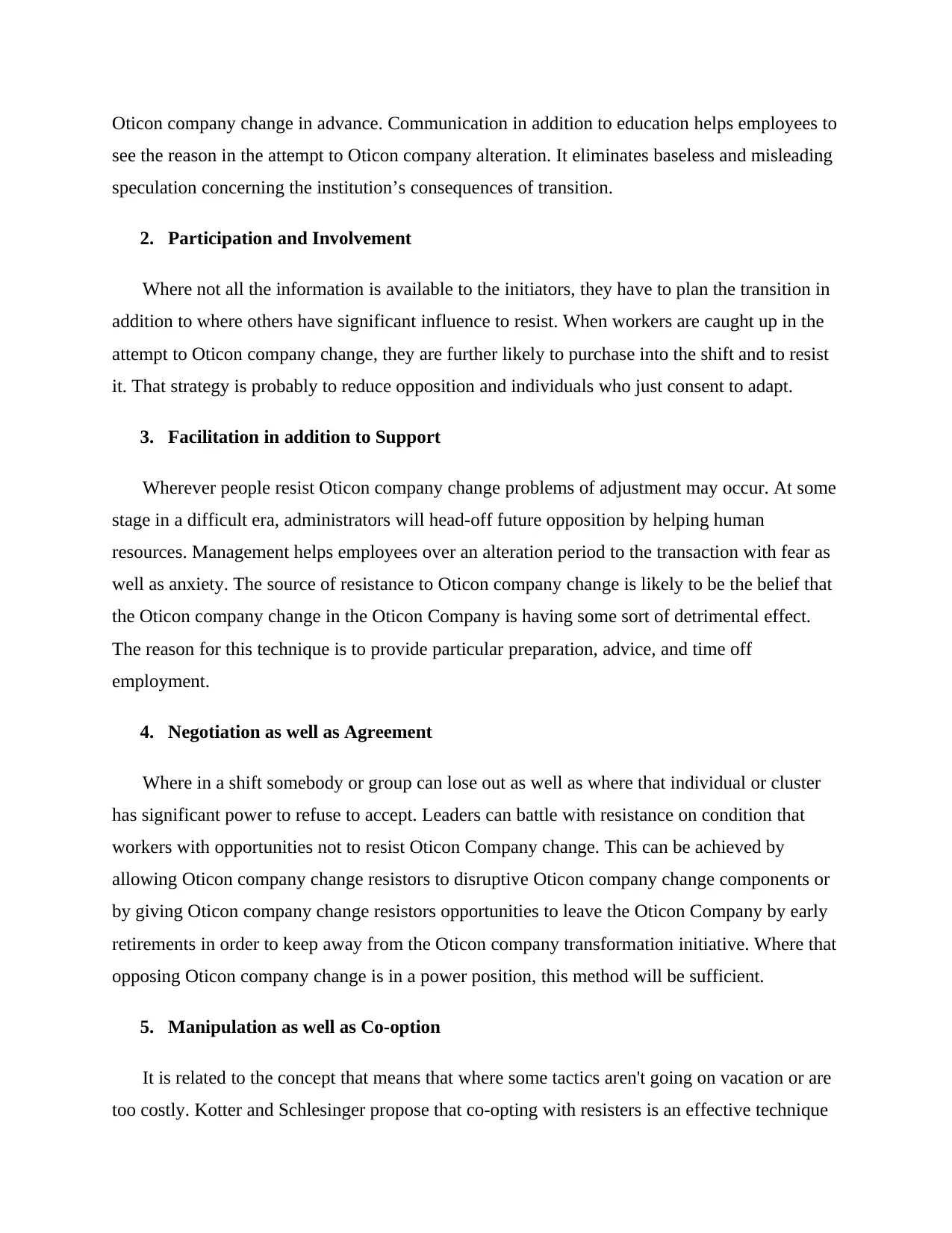
Oticon company change in advance. Communication in addition to education helps employees to
see the reason in the attempt to Oticon company alteration. It eliminates baseless and misleading
speculation concerning the institution’s consequences of transition.
2. Participation and Involvement
Where not all the information is available to the initiators, they have to plan the transition in
addition to where others have significant influence to resist. When workers are caught up in the
attempt to Oticon company change, they are further likely to purchase into the shift and to resist
it. That strategy is probably to reduce opposition and individuals who just consent to adapt.
3. Facilitation in addition to Support
Wherever people resist Oticon company change problems of adjustment may occur. At some
stage in a difficult era, administrators will head-off future opposition by helping human
resources. Management helps employees over an alteration period to the transaction with fear as
well as anxiety. The source of resistance to Oticon company change is likely to be the belief that
the Oticon company change in the Oticon Company is having some sort of detrimental effect.
The reason for this technique is to provide particular preparation, advice, and time off
employment.
4. Negotiation as well as Agreement
Where in a shift somebody or group can lose out as well as where that individual or cluster
has significant power to refuse to accept. Leaders can battle with resistance on condition that
workers with opportunities not to resist Oticon Company change. This can be achieved by
allowing Oticon company change resistors to disruptive Oticon company change components or
by giving Oticon company change resistors opportunities to leave the Oticon Company by early
retirements in order to keep away from the Oticon company transformation initiative. Where that
opposing Oticon company change is in a power position, this method will be sufficient.
5. Manipulation as well as Co-option
It is related to the concept that means that where some tactics aren't going on vacation or are
too costly. Kotter and Schlesinger propose that co-opting with resisters is an effective technique
see the reason in the attempt to Oticon company alteration. It eliminates baseless and misleading
speculation concerning the institution’s consequences of transition.
2. Participation and Involvement
Where not all the information is available to the initiators, they have to plan the transition in
addition to where others have significant influence to resist. When workers are caught up in the
attempt to Oticon company change, they are further likely to purchase into the shift and to resist
it. That strategy is probably to reduce opposition and individuals who just consent to adapt.
3. Facilitation in addition to Support
Wherever people resist Oticon company change problems of adjustment may occur. At some
stage in a difficult era, administrators will head-off future opposition by helping human
resources. Management helps employees over an alteration period to the transaction with fear as
well as anxiety. The source of resistance to Oticon company change is likely to be the belief that
the Oticon company change in the Oticon Company is having some sort of detrimental effect.
The reason for this technique is to provide particular preparation, advice, and time off
employment.
4. Negotiation as well as Agreement
Where in a shift somebody or group can lose out as well as where that individual or cluster
has significant power to refuse to accept. Leaders can battle with resistance on condition that
workers with opportunities not to resist Oticon Company change. This can be achieved by
allowing Oticon company change resistors to disruptive Oticon company change components or
by giving Oticon company change resistors opportunities to leave the Oticon Company by early
retirements in order to keep away from the Oticon company transformation initiative. Where that
opposing Oticon company change is in a power position, this method will be sufficient.
5. Manipulation as well as Co-option
It is related to the concept that means that where some tactics aren't going on vacation or are
too costly. Kotter and Schlesinger propose that co-opting with resisters is an effective technique
Paraphrase This Document
Need a fresh take? Get an instant paraphrase of this document with our AI Paraphraser
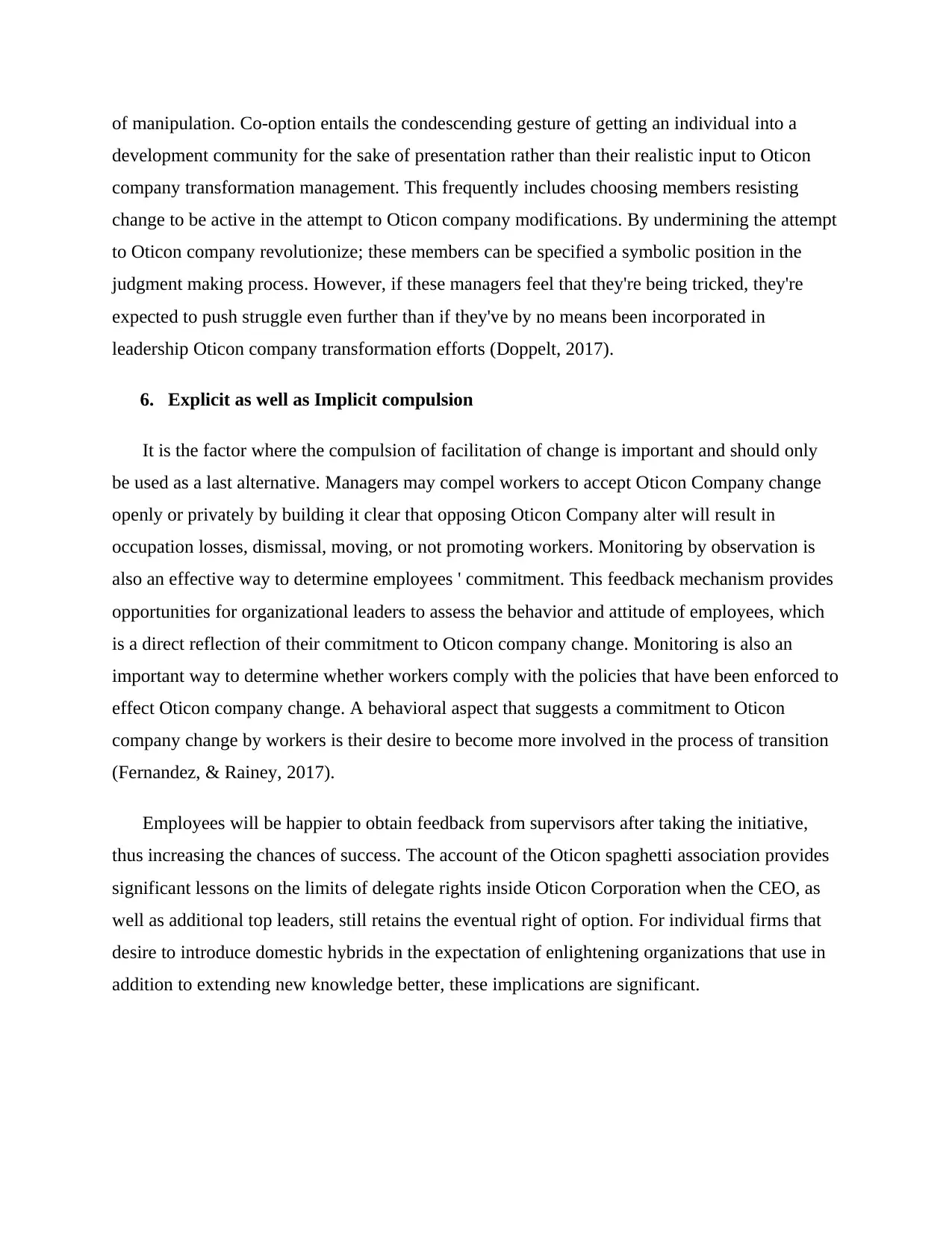
of manipulation. Co-option entails the condescending gesture of getting an individual into a
development community for the sake of presentation rather than their realistic input to Oticon
company transformation management. This frequently includes choosing members resisting
change to be active in the attempt to Oticon company modifications. By undermining the attempt
to Oticon company revolutionize; these members can be specified a symbolic position in the
judgment making process. However, if these managers feel that they're being tricked, they're
expected to push struggle even further than if they've by no means been incorporated in
leadership Oticon company transformation efforts (Doppelt, 2017).
6. Explicit as well as Implicit compulsion
It is the factor where the compulsion of facilitation of change is important and should only
be used as a last alternative. Managers may compel workers to accept Oticon Company change
openly or privately by building it clear that opposing Oticon Company alter will result in
occupation losses, dismissal, moving, or not promoting workers. Monitoring by observation is
also an effective way to determine employees ' commitment. This feedback mechanism provides
opportunities for organizational leaders to assess the behavior and attitude of employees, which
is a direct reflection of their commitment to Oticon company change. Monitoring is also an
important way to determine whether workers comply with the policies that have been enforced to
effect Oticon company change. A behavioral aspect that suggests a commitment to Oticon
company change by workers is their desire to become more involved in the process of transition
(Fernandez, & Rainey, 2017).
Employees will be happier to obtain feedback from supervisors after taking the initiative,
thus increasing the chances of success. The account of the Oticon spaghetti association provides
significant lessons on the limits of delegate rights inside Oticon Corporation when the CEO, as
well as additional top leaders, still retains the eventual right of option. For individual firms that
desire to introduce domestic hybrids in the expectation of enlightening organizations that use in
addition to extending new knowledge better, these implications are significant.
development community for the sake of presentation rather than their realistic input to Oticon
company transformation management. This frequently includes choosing members resisting
change to be active in the attempt to Oticon company modifications. By undermining the attempt
to Oticon company revolutionize; these members can be specified a symbolic position in the
judgment making process. However, if these managers feel that they're being tricked, they're
expected to push struggle even further than if they've by no means been incorporated in
leadership Oticon company transformation efforts (Doppelt, 2017).
6. Explicit as well as Implicit compulsion
It is the factor where the compulsion of facilitation of change is important and should only
be used as a last alternative. Managers may compel workers to accept Oticon Company change
openly or privately by building it clear that opposing Oticon Company alter will result in
occupation losses, dismissal, moving, or not promoting workers. Monitoring by observation is
also an effective way to determine employees ' commitment. This feedback mechanism provides
opportunities for organizational leaders to assess the behavior and attitude of employees, which
is a direct reflection of their commitment to Oticon company change. Monitoring is also an
important way to determine whether workers comply with the policies that have been enforced to
effect Oticon company change. A behavioral aspect that suggests a commitment to Oticon
company change by workers is their desire to become more involved in the process of transition
(Fernandez, & Rainey, 2017).
Employees will be happier to obtain feedback from supervisors after taking the initiative,
thus increasing the chances of success. The account of the Oticon spaghetti association provides
significant lessons on the limits of delegate rights inside Oticon Corporation when the CEO, as
well as additional top leaders, still retains the eventual right of option. For individual firms that
desire to introduce domestic hybrids in the expectation of enlightening organizations that use in
addition to extending new knowledge better, these implications are significant.
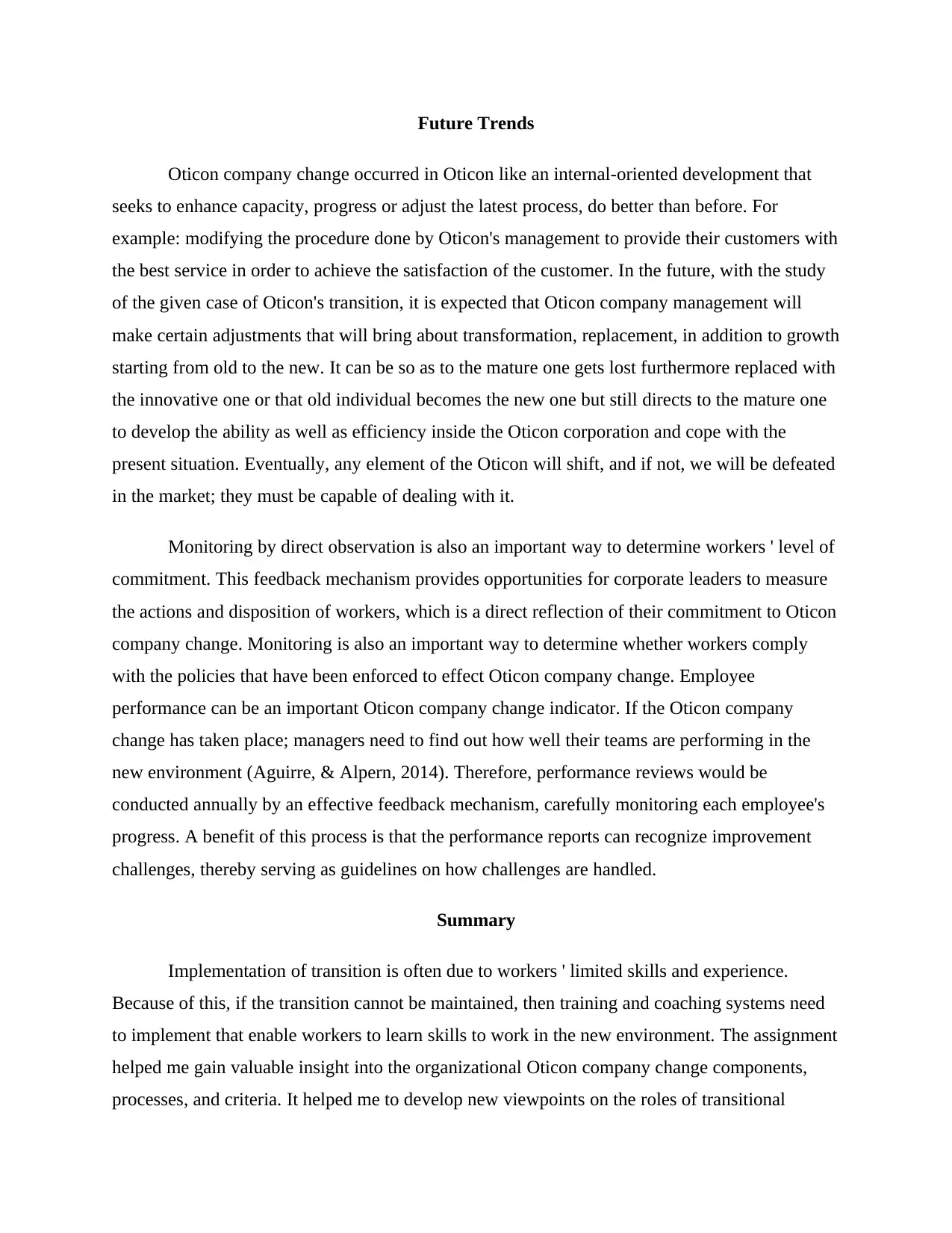
Future Trends
Oticon company change occurred in Oticon like an internal-oriented development that
seeks to enhance capacity, progress or adjust the latest process, do better than before. For
example: modifying the procedure done by Oticon's management to provide their customers with
the best service in order to achieve the satisfaction of the customer. In the future, with the study
of the given case of Oticon's transition, it is expected that Oticon company management will
make certain adjustments that will bring about transformation, replacement, in addition to growth
starting from old to the new. It can be so as to the mature one gets lost furthermore replaced with
the innovative one or that old individual becomes the new one but still directs to the mature one
to develop the ability as well as efficiency inside the Oticon corporation and cope with the
present situation. Eventually, any element of the Oticon will shift, and if not, we will be defeated
in the market; they must be capable of dealing with it.
Monitoring by direct observation is also an important way to determine workers ' level of
commitment. This feedback mechanism provides opportunities for corporate leaders to measure
the actions and disposition of workers, which is a direct reflection of their commitment to Oticon
company change. Monitoring is also an important way to determine whether workers comply
with the policies that have been enforced to effect Oticon company change. Employee
performance can be an important Oticon company change indicator. If the Oticon company
change has taken place; managers need to find out how well their teams are performing in the
new environment (Aguirre, & Alpern, 2014). Therefore, performance reviews would be
conducted annually by an effective feedback mechanism, carefully monitoring each employee's
progress. A benefit of this process is that the performance reports can recognize improvement
challenges, thereby serving as guidelines on how challenges are handled.
Summary
Implementation of transition is often due to workers ' limited skills and experience.
Because of this, if the transition cannot be maintained, then training and coaching systems need
to implement that enable workers to learn skills to work in the new environment. The assignment
helped me gain valuable insight into the organizational Oticon company change components,
processes, and criteria. It helped me to develop new viewpoints on the roles of transitional
Oticon company change occurred in Oticon like an internal-oriented development that
seeks to enhance capacity, progress or adjust the latest process, do better than before. For
example: modifying the procedure done by Oticon's management to provide their customers with
the best service in order to achieve the satisfaction of the customer. In the future, with the study
of the given case of Oticon's transition, it is expected that Oticon company management will
make certain adjustments that will bring about transformation, replacement, in addition to growth
starting from old to the new. It can be so as to the mature one gets lost furthermore replaced with
the innovative one or that old individual becomes the new one but still directs to the mature one
to develop the ability as well as efficiency inside the Oticon corporation and cope with the
present situation. Eventually, any element of the Oticon will shift, and if not, we will be defeated
in the market; they must be capable of dealing with it.
Monitoring by direct observation is also an important way to determine workers ' level of
commitment. This feedback mechanism provides opportunities for corporate leaders to measure
the actions and disposition of workers, which is a direct reflection of their commitment to Oticon
company change. Monitoring is also an important way to determine whether workers comply
with the policies that have been enforced to effect Oticon company change. Employee
performance can be an important Oticon company change indicator. If the Oticon company
change has taken place; managers need to find out how well their teams are performing in the
new environment (Aguirre, & Alpern, 2014). Therefore, performance reviews would be
conducted annually by an effective feedback mechanism, carefully monitoring each employee's
progress. A benefit of this process is that the performance reports can recognize improvement
challenges, thereby serving as guidelines on how challenges are handled.
Summary
Implementation of transition is often due to workers ' limited skills and experience.
Because of this, if the transition cannot be maintained, then training and coaching systems need
to implement that enable workers to learn skills to work in the new environment. The assignment
helped me gain valuable insight into the organizational Oticon company change components,
processes, and criteria. It helped me to develop new viewpoints on the roles of transitional
⊘ This is a preview!⊘
Do you want full access?
Subscribe today to unlock all pages.

Trusted by 1+ million students worldwide
1 out of 16
Your All-in-One AI-Powered Toolkit for Academic Success.
+13062052269
info@desklib.com
Available 24*7 on WhatsApp / Email
![[object Object]](/_next/static/media/star-bottom.7253800d.svg)
Unlock your academic potential
Copyright © 2020–2025 A2Z Services. All Rights Reserved. Developed and managed by ZUCOL.